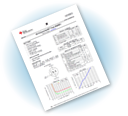Health Service efficiency mapped with simulation tools
23rd July 2008
Source:
Adept Scientific plc
Health Service performance and efficiency and its ability to meet patients’ preferences often comes under scrutiny. Consequently measuring and studying the effects of policy changes on the patient experience is of critical importance. Discrete event simulation models, developed at Lancaster University using Micro Saint Sharp from Adept Scientific, are providing health service managers with the tools to increase efficiency and reduce costs around patient flows.
Simulating patients entering and moving through hospitals, District General Hospital Performance Simulation (DGHPSim) is a suite of models covering outpatients, in-patients and those accessing emergency care. The models can be used to select and refine policies to meet targets, including the 18-week RTT target that requires NHS trusts to ensure patients wait no longer than 18 weeks from GP referral to treatment. 'Smart thinking' is encouraged and supported with outcomes that reduce waiting times whilst avoiding side effects, with 'what if?' tools predicting scenarios based on different actions, rather than causing disruption through experimentation on the floor.
Research Assistant Murat Gunal, responsible for much of the work on DGHPSim, used Micro Saint Sharp because of its flexibility and ease of use for programming. “Inevitably there is a trade-off between the user-friendliness of the software and its suitability to the task,” says Murat, “Micro Saint Sharp has improved continuously since we started using it in 2004.” He adds that the support from Adept Scientific has been first-rate, allowing him to focus on development rather than potential problems.
Now in version 2.6, Micro Saint Sharp uses intuitive graphical user interface and flow charting in a fast, modular modelling tool that allows accurate, flexible and optimised discrete-event simulation. It has helped Murat to build a set of models that, separately, can track the detailed performance of part of a hospital as patients pass through or, collectively, to investigate the interaction between targets and performance.
DGHPSim has been built out of a research project, funded by EPSRC and using HES (Hospital Episode Statistics) as the main data source, also supported by the databases of local hospitals. Murat has used Micro Saint Sharp in other, similar research projects including a UK police force contact centre and a warehouse simulation model for an electrical appliance company to predict staff workloads and room utilisation in their warehouse. “The capabilities of Micro Saint Sharp have helped me to give DGHPSim a range of functions that would otherwise have proved difficult and time consuming,” concludes Murat.
Research Assistant Murat Gunal, responsible for much of the work on DGHPSim, used Micro Saint Sharp because of its flexibility and ease of use for programming. “Inevitably there is a trade-off between the user-friendliness of the software and its suitability to the task,” says Murat, “Micro Saint Sharp has improved continuously since we started using it in 2004.” He adds that the support from Adept Scientific has been first-rate, allowing him to focus on development rather than potential problems.
Now in version 2.6, Micro Saint Sharp uses intuitive graphical user interface and flow charting in a fast, modular modelling tool that allows accurate, flexible and optimised discrete-event simulation. It has helped Murat to build a set of models that, separately, can track the detailed performance of part of a hospital as patients pass through or, collectively, to investigate the interaction between targets and performance.
DGHPSim has been built out of a research project, funded by EPSRC and using HES (Hospital Episode Statistics) as the main data source, also supported by the databases of local hospitals. Murat has used Micro Saint Sharp in other, similar research projects including a UK police force contact centre and a warehouse simulation model for an electrical appliance company to predict staff workloads and room utilisation in their warehouse. “The capabilities of Micro Saint Sharp have helped me to give DGHPSim a range of functions that would otherwise have proved difficult and time consuming,” concludes Murat.
Similar articles
More from Adept Scientific plc
- An exciting new add-on had been added to Maplesoft’s™ MapleSim™ 4th August 2011
- Adept Scientific continues to broaden its data acquisition range 5th July 2011
- Latest MapleSim release opens new avenues for model development 16th June 2011
- New task-based, document-centric calculations environment improves personal and engineering process productivity. 25th January 2011












Write a comment
No comments